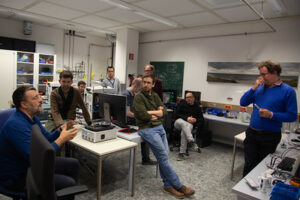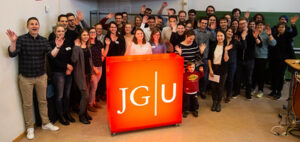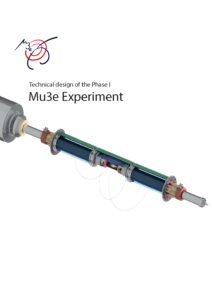High rate precision experiments in particle and hadron physics
We are designing and building high rate experiments to test the Standard Model of elementary particle physics in precision experiments and analysing the resulting data.
News
September 2020
We have published the technical design report for the phase I Mu3e experiment on the arXiv. This report summarizes the results of almost a decade of R&D work and is the basis for the construction of the experiment in the coming two years.
Check it out at https://arxiv.org/abs/2009.11690
November 2019
 All experts for the Mu3e Data Acquistion System (DAQ) assembled in our readout lab in Mainz for a week-long hackathlon producing soft- and firmware for all subdetectors, which will be tested in beam at DESY in February 2020. See the picture gallery.
All experts for the Mu3e Data Acquistion System (DAQ) assembled in our readout lab in Mainz for a week-long hackathlon producing soft- and firmware for all subdetectors, which will be tested in beam at DESY in February 2020. See the picture gallery.
November 2019
 In a beam time at the MAMI we were testing MuPix sensors using short pulses of very high current; no damage to sensors was observerd, giving us further confidence in their radiation tolerance. See the picture gallery.
In a beam time at the MAMI we were testing MuPix sensors using short pulses of very high current; no damage to sensors was observerd, giving us further confidence in their radiation tolerance. See the picture gallery.
October 2019
 Marco Zimmermann has defended his thesis on the simulation and design of the P2 tracking detector. For this, he has simulated the electron signal and various backgrounds, measured the response of MuPix sensors to high energy photons and developed a mechanical and cooling design of the detector. He has simulated the detector using computational fluid dynamics and built a full-size thermo-mechanical mockup for cooling tests with gaseous helium. Have a look at the thesis.
Marco Zimmermann has defended his thesis on the simulation and design of the P2 tracking detector. For this, he has simulated the electron signal and various backgrounds, measured the response of MuPix sensors to high energy photons and developed a mechanical and cooling design of the detector. He has simulated the detector using computational fluid dynamics and built a full-size thermo-mechanical mockup for cooling tests with gaseous helium. Have a look at the thesis.
September 2019
 The annual practical course in particle physics at PSI allowed twelve students from ETH Zürich, Heidelberg and Mainz to build and operate their own detector at the worl's most intense proton accelerator at PSI. Have a look at the picture gallery.
The annual practical course in particle physics at PSI allowed twelve students from ETH Zürich, Heidelberg and Mainz to build and operate their own detector at the worl's most intense proton accelerator at PSI. Have a look at the picture gallery.
May 2019
 Our Mainz readout lab hosted the first Mu3e DAQ (data acquisition) week, where experts from all subsystems got to gether to specify, design and implement soft- and firmware for getting the data out of the detetcor and synchronizing all parts of it; we managed first common run starts and stops. See the picture gallery.
Our Mainz readout lab hosted the first Mu3e DAQ (data acquisition) week, where experts from all subsystems got to gether to specify, design and implement soft- and firmware for getting the data out of the detetcor and synchronizing all parts of it; we managed first common run starts and stops. See the picture gallery.
April 2019
 Ulrich Hartenstein defended his Ph.D. thesis on the track-based alignment of the Mu3e detector. For this he developed software to simulate a mis-aligned detectors and then developed alogirthms to find the positions, orientations and deformations of almost 3000 MuPix sensors using particle tracks passing throgh the detector.
Ulrich Hartenstein defended his Ph.D. thesis on the track-based alignment of the Mu3e detector. For this he developed software to simulate a mis-aligned detectors and then developed alogirthms to find the positions, orientations and deformations of almost 3000 MuPix sensors using particle tracks passing throgh the detector.
The thesis is available here.
April 2019
 The 2019 edition of our interdisciplinary symposium brought together postdocs, Ph.D. and master students from accross JGU. In a series of very lively lectures, they shared their excitement for their research with each other, discussed their ideas and socialized over a barbeque. See the picture gallery.
The 2019 edition of our interdisciplinary symposium brought together postdocs, Ph.D. and master students from accross JGU. In a series of very lively lectures, they shared their excitement for their research with each other, discussed their ideas and socialized over a barbeque. See the picture gallery.
March 2019
 In a beam time in the A2 area of the MAMI accelerator, we tested MuPix pixel sensors as beam monitors for a high-pressure time-projection chamber experiment, which aims at precision studies of electron proton scattering. See the picture gallery.
In a beam time in the A2 area of the MAMI accelerator, we tested MuPix pixel sensors as beam monitors for a high-pressure time-projection chamber experiment, which aims at precision studies of electron proton scattering. See the picture gallery.
Experiments
Currently, we are involved in the following experiments:
 The P2 experiment at the new electron accelerator MESA in Mainz aims to measure the weak mixing angle in electron-proton scattering with unprecedented precision. Our group is designing and building a fast pixel tracker for this experiment.
The P2 experiment at the new electron accelerator MESA in Mainz aims to measure the weak mixing angle in electron-proton scattering with unprecedented precision. Our group is designing and building a fast pixel tracker for this experiment.
 The BES III experiment in Beijing studies electron-positron collisions in the energy range from 2.5 to 4.5 GeV. Our group analyses data from BES in order to understand the meson spectrum, i.e. how the strong nuclear force binds quarks and antiquarks.
The BES III experiment in Beijing studies electron-positron collisions in the energy range from 2.5 to 4.5 GeV. Our group analyses data from BES in order to understand the meson spectrum, i.e. how the strong nuclear force binds quarks and antiquarks.
 The Mu3e experiment searches for the lepton flavour violating decay of a muon to three electrons. For this high precision, high rate experiment we are developing the data acquisition and track reconstruction.
The Mu3e experiment searches for the lepton flavour violating decay of a muon to three electrons. For this high precision, high rate experiment we are developing the data acquisition and track reconstruction.
 The muX experiment studies X-rays emitted from muonic atoms to determine nuclear charge radii of unstable isotopes such as radium and curium. Our group contributed to the data acqusiition system and investigates the feasibility of a measurement of atomic parity violation in muonic zinc or kryprton.
The muX experiment studies X-rays emitted from muonic atoms to determine nuclear charge radii of unstable isotopes such as radium and curium. Our group contributed to the data acqusiition system and investigates the feasibility of a measurement of atomic parity violation in muonic zinc or kryprton.
Technologies
Our involvement in these experiments is based on a set of experimental techniques in which we are continuously developing our expertise:
 High Voltage Monolithic Active Pixel Sensors: A new silicon sensor technology allowing for fast and extremely thin pixellated sensors.
High Voltage Monolithic Active Pixel Sensors: A new silicon sensor technology allowing for fast and extremely thin pixellated sensors.
 Firmware for data transmission and event selection on Field Programmable Gate Arrays (FPGAs): Acquire, sort, transmit and process Gbits to Tbits of data per second using custom firmware on state of the art programmable electronics and connected multi-GBit/s optical links.
Firmware for data transmission and event selection on Field Programmable Gate Arrays (FPGAs): Acquire, sort, transmit and process Gbits to Tbits of data per second using custom firmware on state of the art programmable electronics and connected multi-GBit/s optical links.
 Reconstruction of charged particle tracks is a formidable pattern recognition task in modern high rate detectors. We develop and apply algorithms for fast and accurate track finding, track fitting and detector alignment, both on- and off-line.
Reconstruction of charged particle tracks is a formidable pattern recognition task in modern high rate detectors. We develop and apply algorithms for fast and accurate track finding, track fitting and detector alignment, both on- and off-line.
 Massively parallel computing on graphics cards (GPUs) can help solve the computational challenges of fast track and vertex reconstruction and also be used to speed up amplitude analyses.
Massively parallel computing on graphics cards (GPUs) can help solve the computational challenges of fast track and vertex reconstruction and also be used to speed up amplitude analyses.
 Detector tests using the MuPix telescope: We have built a four layer track telescope from MuPix pixel sensors which can be used for detector tests up to extremely high rates.
Detector tests using the MuPix telescope: We have built a four layer track telescope from MuPix pixel sensors which can be used for detector tests up to extremely high rates.
 Amplitude analysis is a core technology to extract the hadron spectrum from collision data, e.g. form the BES III experiment. We are involved in implementing and optimizing novel models in the analysis and applying them to interesting channels in the BES III data.
Amplitude analysis is a core technology to extract the hadron spectrum from collision data, e.g. form the BES III experiment. We are involved in implementing and optimizing novel models in the analysis and applying them to interesting channels in the BES III data.
Support
We are located at the Institute of Nuclear Physics in Mainz, where we have the unique opportunity of using the MAMI electron accelerator for detector tests and will receive the new MESA accelerator driving the beam for P2.
We are part of the PRISMA+ cluster of excellence in Mainz and collaborate closely with the PRISMA detector lab in the design and construction of experiments.
The activities in P2 and BES III are supported by the DFG collaborative research centre (SFB) 1044.
Our Mu3e activities were funded by a DFG Emmy Noether grant until 2018.




